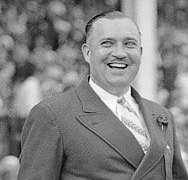Ralph Day
Ralph Carrette Day[1] (November 21, 1898 – May 21, 1976) was mayor of Toronto, Ontario from 1938 to 1940. He was also an accomplished funeral director, owning his own funeral home. He also served as chairman of the Toronto Transit Commission in the 1960s and 1970s. He was also a member of the Orange Order in Canada.
Ralph C. Day | |
|---|---|
 | |
| 46th Mayor of Toronto | |
| In office 1938–1940 | |
| Preceded by | William D. Robbins |
| Succeeded by | Frederick J. Conboy |
| Personal details | |
| Born | November 21, 1898 Toronto, Ontario |
| Died | May 21, 1976 (aged 77) Toronto, Ontario |
| Profession | Mayor of Toronto, First Chairman Parking Authority, Chairman Toronto Transit Commission |
In 1916, at the age of 17, Day joined the Canadian army to fight in World War I. He would fight and survive action at the Battle of Vimy Ridge.
Day entered municipal politics in the 1930s, first as an alderman[2] and then as a controller before being elected mayor in 1938 and served until 1940.
Italian-Canadian men were interned by the federal government shortly after Italy declared war on Canada during World War II; Day announced on June 11, 1940, that their families, despite now lacking a breadwinner, would be denied welfare. "This country is at war with Italy", he stated, "and Italians cannot very well expect us to spend money for war purposes for the purpose of maintaining alien enemies."[3]
In 1963 Day became chairman of the Toronto Transit Commission, a position he would hold until 1972.
The Ralph Day Funeral Home still operates but has since merged with another Day family acquisition. "Heritage Funeral Centre, Ralph Day Chapel" is in Toronto on Overlea Boulevard.
Personal life
With his wife Vera he had two daughters, Marie and Shirley and one son, Glen. His son would marry former mayor Allan A. Lamport's daughter.
References
| Archives at | ||||||
|---|---|---|---|---|---|---|
|
||||||
| Using archival material | ||||||
|
Help:Archival material Finding aids |
- During his time as an alderman, Day was on the general committee for the Centennial of the City of Toronto.
- Toronto Star, May 21, 1976
| Political offices | ||
|---|---|---|
| Preceded by C. C. Downey |
Chairman of the Toronto Transit Commission 1963–1972 |
Succeeded by Franklin I. Young |